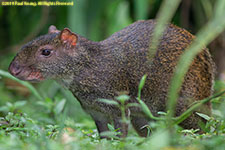
We visited Ecuador in November, 2019.
Central American agouti, Dasyprocta punctata. Agoutis are a medium-sized rodent native to Central America and northern South America. They are related to guinea pigs. Agoutis have five toes on their front feet and three toes on their hind feet, and short to nonexistent tails.
Capybara, Hydrochaeris hydrochaeris. The capybara is the largest rodent and is native to South America. They are related to guinea pigs and distantly related to agoutis.
Red-tailed squirrel, Notosciurus granatensis. The red-tailed squirrel is a large tree squirrel native to southern Central America and northern South America.
Long-nosed bat (proboscis bat), Rhynchonycteris naso. This bat is found in South and Central America. They live in colonies of five to ten individuals.
Marine mammals:
Giant (river) otter, Pteronura brasiliensis. The giant river otter is the largest otter. It is carnivorous and related to the weasel. They live in family groups of three to eight animals. They are found in north-central South America and are endangered.
Amazon river dolphin (pink river dolphin), Inia geoffrensis. The pink river dolphin is a toothed whale. They are the largest river dolphins, with adult males reaching 185 kg and more than 2.5 m in length. Adults develop a pinkish color. Like other toothed whales they have a melon, used for sonar.
Monkeys:
Silvery woolly monkey (Poeppig's woolly monkey), Lagothrix poeppigii. Woolly monkeys are related to spider monkeys. They are found throughout northern South America.
White-fronted spider monkey (white-bellied spider monkey, long-haired spider monkey), Ateles belzebuth. Spider monkeys are found in the tropical forests of Central and South America, foraging in the high canopy. They mainly eat fruits.
Ecuadorian squirrel monkey (Humboldt's squirrel monkey), Saimiri casiquiarensis macrodor. Squirrel monkeys live in the tropical forests of Central and South America, speding most of their time in the forest canopy.
Ecuadorian capuchin (Ecuadorian white-fronted capuchin), Cebus aequatorialis (Cebus albifrons aequatorialis). Capuchin monkeys are found in Central and South America. The word "capuchin" comes from an order of Franciscan monks whose brown hooded robes resemble the monkeys' coloration.
Venezuelan red howler, Alouatta seniculus. Howler monkeys are among the largest of New World monkeys. Their loud howls can be heard for over three miles through dense rainforest. They are native to Central and South America. They have a very keen sense of smell.
Napo saki, (Napo monk saki), Prothecia napensis (Pithecia napensis). Saki monkeys live in northern and central South America. They are small and have long bushy tails. They tend to be very shy and cautious.
White-tailed titi, Plecturocebus discolor (Collicebus discolor). Titi monkeys live in dense forests near water. The tail is longer than the head and body, and is not prehensile. They live in family groups of parents and offspring.
Felines:
Jaguar, Panthera onca. The janguar's range extends from the southwest United States south to Paraguay and Argentina. It is the largest native cat species in the New World, and the third largest overall.
Puma (cougar, mountain lion, catamount), Puma concolor. Pumas range from the Canadian Yukon to the southern Andes. They are the second-heaviest New World cat after the jaguar.
Margay, Leopardus wiedii. The margay is a small wild cat nsative to Central and South America. These solitary nocturnal cats live in primary evergreen and deciduous forest. They look like large ocelots.
Ocelot, Leopardus pardalis. The ocelot is a small wild cat native to the southwest United States, Mexico, and Central and South America. They are active at twilight and at night,
Other mammals:
Culpeo (Andean fox), Lycalopex culpaeus. The culpeo is a South American fox. It resembles a red fox. Culpeos eat rodents, birds, and lizards.
Linnaeus's two-toed sloth, Choloepus didactylus. Sloths are arboreal animals that spend most of theit lives hanging upside down in tropical rainforest trees.
Llama, Lama glama. The llama is a domesticated South American camelid, raised for meat and as a pack animal by Andean cultures since pre-Columbian times.
White-tailed deer, Odocoileus astus. The white-tailed deer is a medium-sized deer native to North America, Central America, and part of South America. It is the New World's most widely distributed ungulate.
Andean bear (spectacled bear, Andean short-faced bear, mountain bear), Tremarctos ornatus. The Andean bear is the last extant short-faced bear and the only bear native to South America. It is the largest South American carnivore.
Crab-eating raccoon (South American raccoon), Procyon cancrivorus. The crab-eating raccoon is native to marshy and jungle areas of Central and South America. It is an omnivore.
Coati (coatimundi), Nasua nasua. Coatis are native to the southwest United States, Mexico, Central America, and South America. Males can be twice as large as females. They have light brown or black coats.
Amazon tapir, Tapirus terrestus. Tapirs are large herbivorous animals similar in shape to pigs, with a short prehensile nose trunk. They are related to horses, donkeys, zebras, and rhinoceroses.
Collared peccary, Pecari tajacu. Peccaries are found throughout Central and South America and southwest North America. They are omnivorous.
©2019, 2020 Mermaid Underwater Photographic. All Rights Reserved.
This page sponsored by Mermaid Underwater Photographic. Contact us at mermaid@underwater.org.
Last modified 30 March 2020